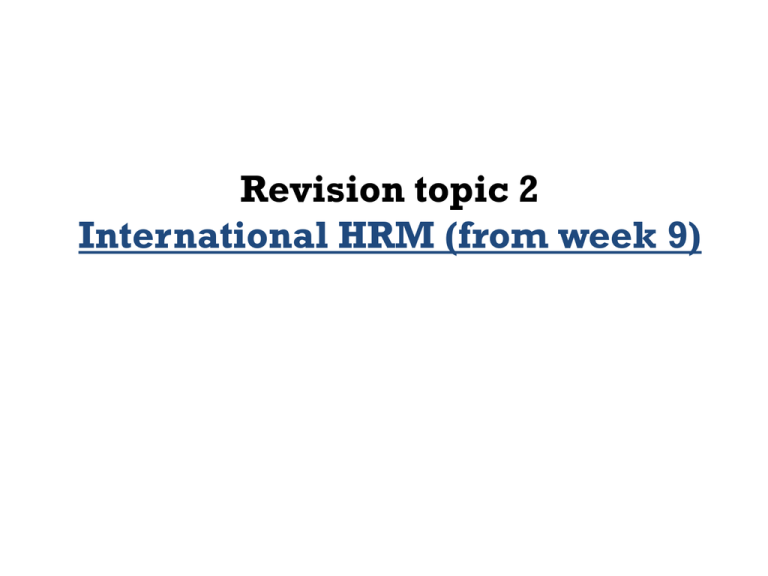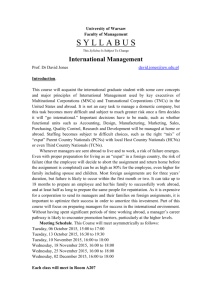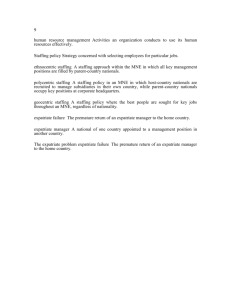Approaches to Global Staffing
advertisement

Revision topic 2 International HRM (from week 9) Types of Global Staff Members • Home country national or Parent country national: Employee working in firm who is not a citizen of country in which firm is located, but a citizen of country where organization is headquartered • Host-country national: Employee’s nationality same as location of subsidiary • Third-country national: Citizen of one country, working in second country, and employed by organization headquartered in third country Parent-country Nationals Advantages Control and co-ordination by HQ is maintained. Disadvantages HCNs promotion opportunities are limited. Adaptation to host country may take a long time. Promising managers get international experience. PCNs may be the best people for the job. Assurance that the subsidiary will comply with company objectives policies etc. PCNs may impose an inappropriate HQ style. Compensation differences between PCNs and HCNs may cause problems. (Torrington, Hall, and Taylor, 2011) Host-country Nationals Advantages • No problems with language and culture. Disadvantages • HQ may have less control over operations. • HCNs may still have limited career opportunities outside the subsidiary. • Reduced hiring costs. • No work permits required. • Continuity of management improves since HCNs stay longer in positions. • Hiring HCNs limits opportunities for PCNs to gain overseas experience. • Govt. policy may force hiring of HCNs. • • Promotional opportunities not limited - so higher morale among HCNs. Hiring HCNs may encourage a federation of disintegrated national units rather than one integrated global unit. (Torrington, Hall, and Taylor, 2011) Third-country Nationals Disadvantages Advantages • Salary and compensation may be lower than for PCNs. • May be more familiar with host country than the PCNs. • Transfers must consider national animosities. • Host government may resent TCNs as much as PCNs. • TCNs may not comply with HQ style of management. • TCNs may not want to return after assignment. (Torrington, Hall, and Taylor, 2011) Employees in an International Workforce • When organizations operate overseas, they hire a combination of parent-country nationals, host-country nationals, or third-country nationals. • Expatriates – employees assigned to work in another country. Approaches to Global Staffing • Ethnocentric staffing: Primarily hiring expatriates for higher-level foreign positions • In this approach, all key management positions are held by parent country nationals. • Ethnocentric corporations believe that home country nationals are more intelligent, reliable and trust worthy than foreign nationals • Example, when a Japanese corporation invests in Mexico, Japan is the home country and Mexico is the host country. If the Japanese Corporation is ethnocentric, it will except Mexicans to accept the inherent superiority of Japan. Investments will be made on the Japanese methods of conducting business. (Perlmutter H 1969,1974) Approaches to Global Staffing • Polycentric staffing: More host-country nationals are used throughout the organization, from top to bottom. • The polycentric staffing requires host country nationals to be hired to manage subsidiaries, while parent-country nationals occupy key positions at corporate headquarters • The polycentric message is: ‘Local people know what is best for them’. • Employing HCNs eliminate language problems for the expatriates and their family members, reduces cost on costly awareness training programs, and takes care of the adjustment problems to a large extent. (Perlmutter H 1969,1974) Approaches to Global Staffing (Cont.) • Regiocentric staffing: Regional groups of subsidiaries reflect organization’s strategy and structure work as a unit • • • These are regionally oriented organizations. A Corporation implements a regional strategy when synergistic benefits can be obtained by sharing functions across regions. • Regional headquarter organizes collaborative efforts among local subsidiaries, • The international staff is transferred with in the same region they work, • For example: a manager working in Asia-Pacific region will be moving within the same region only, if the company adopts regiocentric approach • (Perlmutter H 1969,1974) Approaches to Global Staffing (Cont.) • Geocentric staffing: Using worldwide integrated business strategy to hire the best person for the job • This staffing philosophy seeks the best people for key jobs throughout the organization, regardless of nationality, selecting the best person for the job, irrespective of nationality is most consistent with the underlying philosophy of a global corporation • The MNC is taking a global approach to its operation, recognizing that each part (subsidiaries and headquarters) makes a unique contribution with its unique competence • It is accompanied by a worldwide integrated business and nationality is ignored in favour of ability. (Perlmutter H 1969,1974) Unions Operations Human Resource Management Finance Safety and Health Customers Competition Other Functional Areas Labor Market Shareholders Political Parties Marketing Society Unanticipated Events Economy GLOBAL ENVIRONMENT EXTERNAL ENVIRONMENT INTERNAL ENVIRONMENT Technology Legal Considerations Challenges to International Human Resource Management Practice questions 1. Discuss ethnocentrism, polycentrism, regiocentrism and geocentrism staffing approaches and explain its importance to the Multi National Companies. You should analyse strength and limitation of each approach. 2. What are the challenges to HRM in the MNCs or in the Global Company? Explain in detail and provide examples. • 1. Discuss different types of expatriate and explain advantages and disadvantages of employing expatriate by MNCs.





